Throughout Ukraine’s history as an independent nation, there have been a total of 18 defence ministers. While some of them have left a negative impression, most of them are not remembered by the general public. Among the more recent ministers, there are those whose professional qualities are respected by some and criticised by others. However, it is undeniable that the most prominent figure among all of these officials is the first minister, General Kostiantyn Morozov.
The National Military-Historical Museum of Ukraine houses a vast collection of photographs and personal belongings of the first minister, including uniforms, insignia, honorary weapons, officer swords, and decorations. One of the most interesting items in the collection is the pilot’s suit worn by Kostiantyn Morozov during his introductory flight on an F-16 aircraft in April 1992, during an official visit to the airbase in Las Vegas, USA. The collection also boasts the military oath signed by the general on December 6, 1991 and photographs of Kostiantyn Morozov near the F-16 “Falcon Flight” aircraft on which he flew. Additionally, the collection includes various photo albums from his official visits to France (August 31 – September 3, 1992), the United Kingdom (December 6–11, 1992), and the United States (1993).
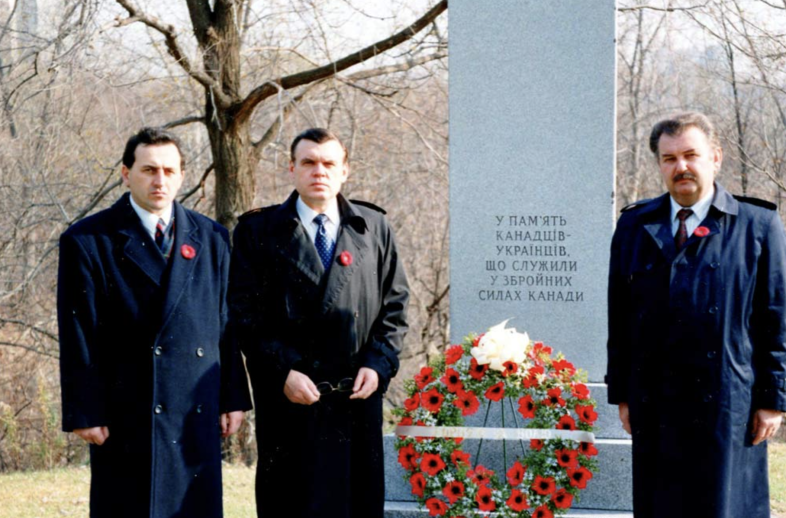
Kostiantyn Morozov during an official visit to Canada near the monument to Ukrainian soldiers of the Canadian Armed Forces, 1992. Interestingly, the poppy flower symbol was on the lapel—a sign of honour for those who perished in World War II. The symbol began to be used in Ukraine in 2015.
The beginnings
As you flip through Kostiantyn Morozov’s photo albums from his foreign trips in 1992, you can’t help but be amazed at how effortlessly he carried himself and how comfortable he looked standing alongside British aristocrats and brave American military personnel. This is in stark contrast to many other representatives of Ukraine on the world stage.
Kostiantyn Morozov was a prominent figure in the newly restored Ukrainian state between 1991 and 1993. He was the commander of the Air Army stationed in Ukraine and played a crucial role in supporting the proclamation of the Act of Independence on August 24, 1991. While many other commanders of military districts and armies in Kyiv, Odesa, and Prykarpattia Military Districts remained loyal to the USSR, Morozov stood in support of Ukraine’s independence.
Kostiantyn Morozov was appointed as Ukraine’s Minister of Defence on September 3. Within a week, on September 9-10, he met with the Soviet Minister of Defence, Air Marshal Yevgeny Shaposhnikov, where he announced Ukraine’s plan to create and fully equip its own army. On September 16, 1991, the first meeting of a group of military officials was held in Kyiv to initiate work on the National Security Concept, the Military Doctrine of Ukraine, and the necessary legislative framework. During the autumn of 1991, an organisational group of around 30 generals and officers formed within the Ministry of Defence of Ukraine.
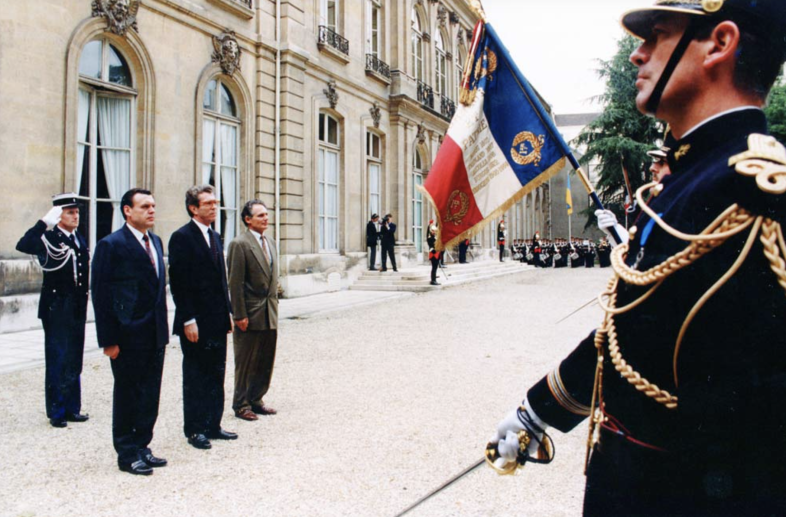
Arrival for an official visit to France on August 31, 1992.
The Soviet military stationed on Ukrainian soil was a massive, disorganised group made up of various elements within the larger USSR military machine. It consisted of 726,536 soldiers and almost 180,000 civilian workers. The group needed to be downsized to 450,000, allowing those who did not want to serve Ukraine to depart while properly organising those returning to their respective homelands.
On October 11, 1991, General Kostiantyn Morozov presented the Concept of Defence and Construction of the Armed Forces of Ukraine in the Verkhovna Rada of Ukraine. The project proposed the elimination of three military districts, 11 different armies, and the Black Sea Fleet, which would be subsequently reformed. Instead, the proposal was to establish four operational commands (East, West, North, South), a separate corps in Crimea, and the Ukrainian Navy over time. It’s noteworthy that the new structure for the Armed Forces of Ukraine was only implemented in 2015, which means that 23 years were wasted.
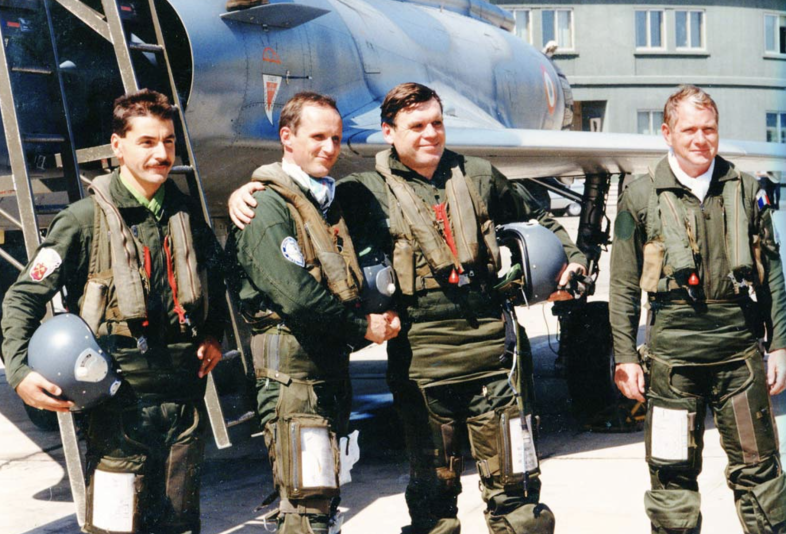
In France, Kostiantyn Morozov also tested on one of the modern fighter jets.
The Soviet past
Since the autumn of 1991, all Ukrainian conscripts have been serving in their home country. On December 6th, the Verkhovna Rada of Ukraine passed two laws, “On the Defence of Ukraine” and “On the Armed Forces of Ukraine”, which included the Military Oath. General Kostiantyn Morozov was the first military serviceman of the Armed Forces of Ukraine and he took the oath directly in the hall of the Verkhovna Rada of Ukraine. This event marked the beginning of the Armed Forces of Ukraine, and since then, December 6th has been celebrated as the Day of the Armed Forces of Ukraine.
On January 3, 1992, at the Ministry of Defence of Ukraine, 28 generals and over 300 officers from the central apparatus of the Ministry of Defence and the General Staff took an oath in an elevated atmosphere. Following the first minister’s dismissal in October 1993, the Ministry was renamed in a manner that reflected more Soviet-Russian influence than Western influence.
In the early 1990s, Ukrainians replaced Russians and representatives of other nationalities in the military. Officers and ensigns from various parts of the Soviet Union and Warsaw Pact countries would often take leave, arrive at the Kyiv railway station, and walk to the Ministry of Defence of Ukraine with their suitcases. There, they would swear allegiance to the people of Ukraine near the checkpoint. The most active period of personnel appointments was the summer and autumn of 1992, when Kostiantyn Morozov and his small circle worked day and night.
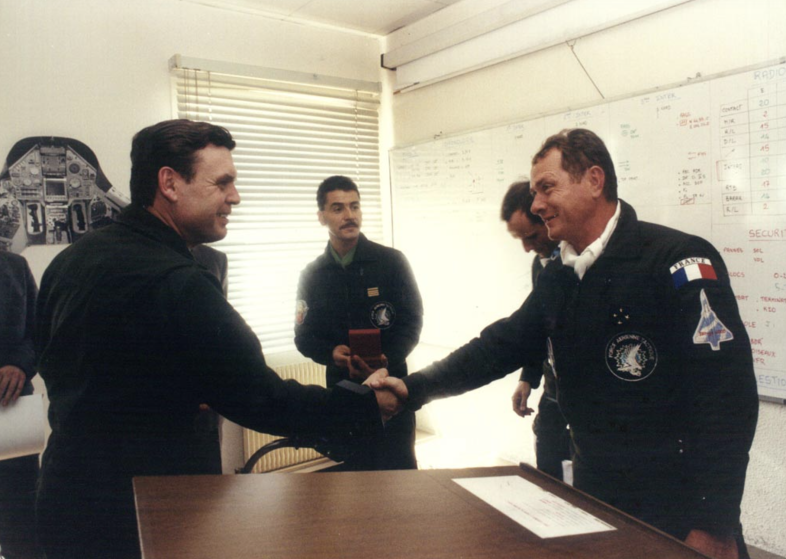
Meeting fellow pilots at the French airbase.
The Language
The language issue in the activities of the Ministry of Defence of Ukraine and the Armed Forces (ZSU) during the early 1990s was quite interesting. As of October 11, 1993, the central apparatus of the Ministry of Defence of Ukraine had 1121 Ukrainians, 498 Russians, 30 Belarusians, and 26 representatives of other nationalities. However, over 80% of them were generals, colonels, and lieutenant colonels who mostly did not speak Ukrainian. As a result, not only the language of communication but also official documentation was in Russian. Even the initial orders and directives of the Ministry of Defence of Ukraine and the General Staff were written in Russian. Only in the spring of 1992 did Ukrainian-language orders begin to appear alongside official documents in Russian. General Kostiantyn Morozov played a significant role in this process due to his personal stance, although he did not speak Ukrainian. He started learning to speak and write Ukrainian in the spring of 1992. By 1994, when the author personally met General Kostiantyn Morozov, he was already quite proficient in speaking and could address people in Ukrainian.
The Union of Ukrainian Officers had a significant influence on the Ukrainianisation of the Armed Forces of Ukraine. They were known to voice their opinions to the first Minister of Defence, who listened to them carefully. One example of their influence was the appointment of Reserve Sergeant Volodymyr Muliavyi as the head of the social-psychological service, with the rank of colonel. The social-psychological service had its positive and negative qualities, and the appointment of Muliavyi, along with the cooperation with the Union of Ukrainian Officers, played a dual role in the political and military environment of Ukraine in the early 1990s. It was one of the reasons for the resignation of Kostiantyn Morozov, at least according to what was said at the time.
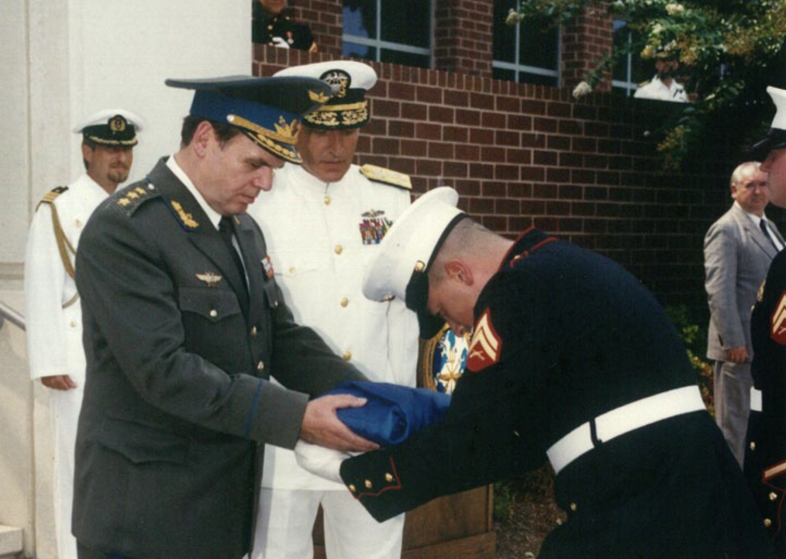
General Colonel Kostiantyn Morozov is meeting the Commander-in-Chief of the United States Atlantic Fleet, Paul D. Miller. According to American tradition, the Minister of Defence of Ukraine, as an honorary guest, ceremoniously receives the national flag used during the ceremony.
Fatal changes
In the fall of 1993, there were significant changes in how Ukrainian leadership approached the Armed Forces (ZSU), and their internal personnel policies within the military. Prior to this, there were negotiations between Russia and Ukraine about the status of Crimea, the fate of the Black Sea Fleet, nuclear weapons, and other matters. It appears that certain agreements were made between the leaders of the two countries, particularly concerning personnel issues that are still unknown to us. On October 8, 1993, Kostiantyn Morozov resigned from his position as the Minister of Defence, 11 days before the Verkhovna Rada approved the Military Doctrine of Ukraine on October 19. The reason for his resignation was due to a disagreement with Ukrainian President Leonid Kravchuk on the future of the Black Sea Fleet in Crimea. The general’s resignation was deeply felt within the military community who had worked on establishing the Armed Forces of Ukraine, as well as among patriotic Ukrainians.
A group of military graduates from academies in Moscow and Leningrad arrived in Ukraine simultaneously. They consisted of generals, colonels, lieutenant colonels, and majors. At the Georgievsky Hall of the Kremlin, they made a pledge to their colleagues who remained in the Commonwealth of Independent States (CIS): they would not go to war and would remain loyal to one another. There were over 700 of those individuals had graduated from various military academies, including the General Staff Military Academy, academies named after Frunze, Lenin, Malinovsky, Budyonny, Kalinin, Kuybyshev, Gagarin, Kirov, Dzerzhinsky, and others. The graduates included Ukrainians and representatives of other nationalities who had served for some time in the Kyiv, Odesa, or Prykarpattia districts. Many of them had settled down, obtained apartments, started families, and considered their future service in the country to be “comfortable.”
After the creation of Ukraine’s Armed Forces in 1992-1993, academicians were appointed by new defence ministers to key positions in the Ministry of Defence, General Staff, district and corps headquarters, divisions, brigades, and regiments. This led to the dismissal or reassignment of generals and officers who had taken command positions during that time, undermining the work of Kostiantyn Morozov and his initiative group in creating the Armed Forces of Ukraine. As a result, the reforms and downsizing efforts made during 1992-1993 were dismantled, and the Armed Forces of Ukraine entered into a slow process of decay.
Soviet-era military personnel who were trained in Soviet-Russian military academies came to Ukraine. Their influence continued in the Armed Forces of Ukraine until 2014. When they arrived, the sleeve insignia of the Armed Forces of Ukraine changed from a noble emblem with a trident in a European style to a Soviet-style “poster” with agrarian symbolism. After this, military personnel often used the term “collective farm Ukraine” to refer to the Armed Forces of Ukraine.
The situation underwent a fundamental change following the armed aggression by the Russian Federation in 2014. It was only then that the Armed Forces of Ukraine returned to the path that had been defined during the leadership of the Ministry of Defence of Ukraine under Kostiantyn Morozov.
An album was prepared to mark the meeting with Paul Miller, the Ukraine’s Defence Minister and Paul D. Miller. American admiral wrote:
To General-Colonel Morozov,
Your visit to SACLANT [Supreme Allied Commander Atlantic] / Norfolk / Washington brought us much joy. We hope that every aspect of the visit will leave special memories. Wishing you all the best in your future endeavors and looking forward to collaborating with you in important times ahead.
Paul D. Miller
United States Navy Admiral

